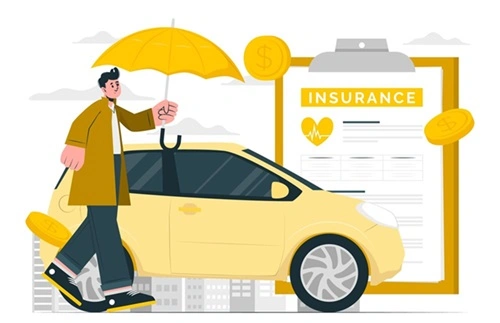If you own a car or a motorcycle, you need motor insurance. Have you ever thought about how insurers determine your premium?
Whether you’re getting a new motor insurance policy or renewing an existing one, knowing how to calculate motor insurance premium can help you select the best plan and prevent overpaying. This blog examines the key factors that affect your premium and provides tips on how to reduce it.

What is a Motor Insurance Premium?
A motor insurance premium is the amount you pay to your insurer each year or every six months to protect your vehicle from accidents, theft, disasters, and third-party liabilities. Your premium is influenced by several factors, including whether you have a third-party or comprehensive policy, the specifications of your vehicle, your location, your driving history, and any optional add-ons you choose.
Paying on time ensures your coverage stays current and protects you throughout the policy period.
Factors Affecting Premium Calculation
Motor insurance premiums can vary widely. Here’s what impacts them the most:
1. Type of Vehicle
The kind of car you own significantly affects how to calculate motor insurance premiums.
- Make and Model: Luxury cars or foreign models usually come with higher premiums because their maintenance costs are higher.
- Vehicle Segment: Two-wheelers usually have lower premiums than four-wheelers. Commercial vehicles cost more to insure than personal ones.
- Fuel Type: Diesel vehicles have significantly higher premiums due to higher maintenance costs. CNG and LPG kits can affect rates depending on their installation.
- Engine Capacity: In India, third-party insurance premiums depend on engine capacity. A higher engine capacity typically results in higher premiums.
- Modifications: Upgrades like alloy wheels or performance improvements increase the premium by raising the vehicle’s risk or value.
2. Insured Declared Value (IDV)
IDV is your vehicle’s current market value, which sets the maximum payout if your vehicle is completely lost or stolen. A higher IDV means a higher premium. However, choosing an IDV that is too low can result in a lower claim amount. It is crucial to find the right balance.
Schedule of depreciation for arriving at IDV:
| Age of the Vehicle Percentage of depreciation for fixing IDV | Percentage of depreciation for fixing IDV |
| Not exceeding 6 months | 5% |
| Exceeding 6 months but not exceeding 1 year | 15% |
| Exceeding 1 year but not exceeding 2 years | 20% |
| Exceeding 2 years but not exceeding 3 years | 30% |
| Exceeding 3 years but not exceeding 4 years | 40% |
| Exceeding 4 years but not exceeding 5 years | 50% |
3. Location and Usage
- Registration Location: Premiums are higher in metropolitan cities, such as Mumbai and Delhi, due to the increased risk of theft and accidents. Rural areas have lower premiums.
- Parking Conditions: Parking in covered garages can lower your premium. Street parking in high-risk areas may increase it.
- Vehicle Usage: Using your vehicle for commercial purposes or long-distance travel results in higher premiums due to the increased risk. Vehicles used for personal purposes usually cost less to insure.
4. No Claims Bonus (NCB)
NCB is a discount on your premium for not making any claims during the previous motor insurance policy period. It increases every year without a claim and can go up to 50%.
- NCB can be transferred between insurers and vehicles.
- If you make one claim without a protection add-on, the NCB resets to zero.
- This applies only to the own-damage portion of the policy, not to third-party coverage.
How to Calculate Premium Online
Calculating your motor insurance policy premium online is easy:
- Visit an insurance or comparison website.
- Enter your vehicle information, including type, model, fuel type, engine size, and city.
- Select the type of policy: third-party or comprehensive.
- Set your IDV. A higher IDV provides more coverage but comes at a higher cost.
- Choose extra add-ons, such as 0% depreciation, NCB protection, and engine cover.
- Look for discounts like NCB, voluntary deductibles, or anti-theft devices.
- View premium estimates. Change the variables to compare different plans.
Tips for Lowering Motor Insurance Premiums
You don’t have to pay a high premium to get the best auto insurance. Here are some practical ways to save money:
- Compare Plans Online: Utilise reliable comparison websites to find policies that best suit your needs.
- Set the appropriate IDV: Avoid over- or under-insuring your car. Choose your IDV wisely.
- Use No Claim Bonus: Keep your NCB by avoiding minor claims and driving safely.
- Install Anti-theft Gadgets: Certified gadgets can save you money while improving vehicle security.
- Choose Voluntary Deductibles: If you’re a confident driver, agreeing to pay a portion of the claim can lower your premium.
- Avoid Minor Claims: Paying out of pocket for small repairs helps you keep your NCB.
- Bundle Insurance Policies: Buying car and health insurance from the same provider may lead to loyalty discounts.
- Select Add-ons Carefully: Choose only add-ons that fit your usage and vehicle condition.
- Maintain a Clean Driving Record: Fewer accidents mean less risk, resulting in lower premiums.
Final Thoughts
Understanding how motor insurance premiums are calculated helps you make better choices about your policy. The type of vehicle you drive, how you use it, where you live, your IDV, and your driving history all play a role. You can find the best motor insurance without overspending by using tools like online premium calculators and strategies such as saving NCB and comparing policies.
Remember, don’t just choose the cheapest option. Look for a policy that offers a good balance of cost, coverage, and reliability when you need to make a claim. Keep your policy active, review it regularly, and renew it on time to ensure ongoing protection without stress.

